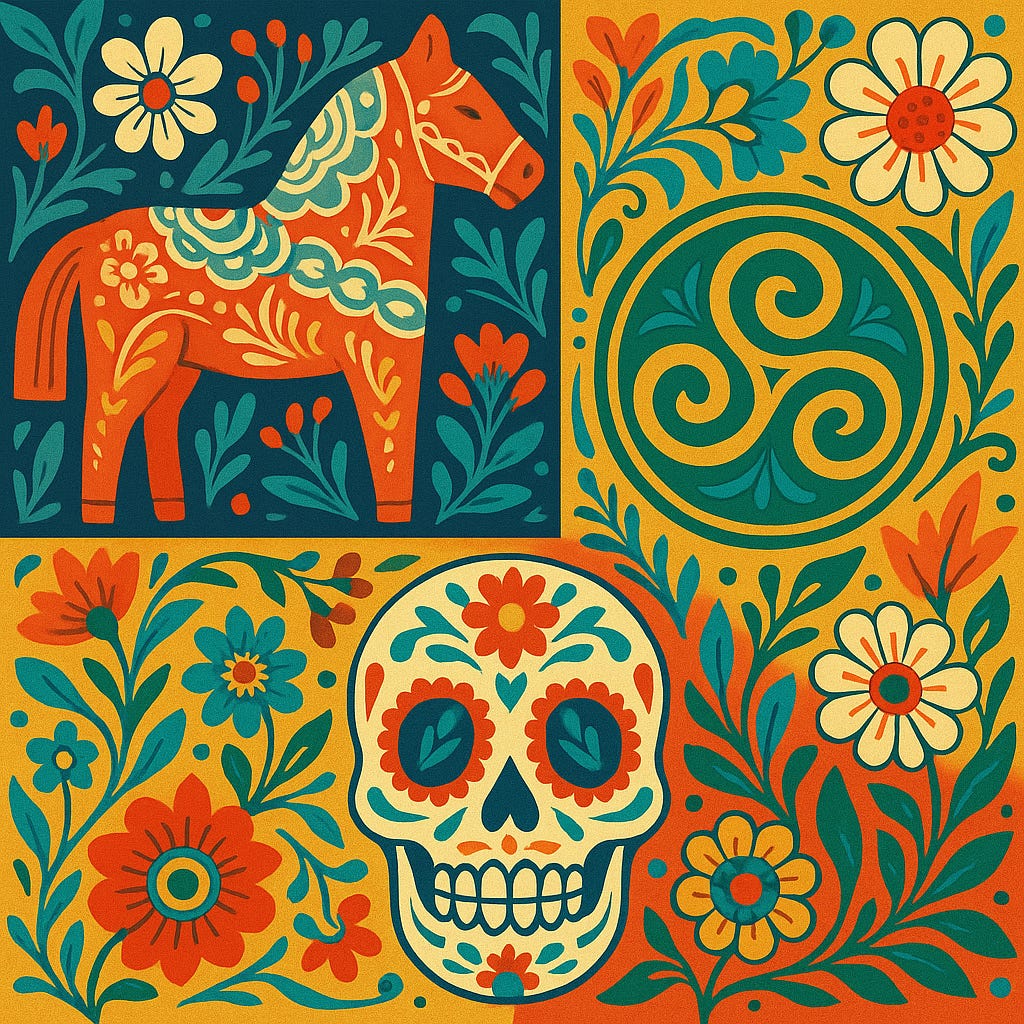A Community Woven on Canvas
How layered cultures shape my art — and why plurality matters more than ever
A Community on Canvas

Excerpt:
Our country’s cultural tapestry is under threat, but on my canvas it lives on — a colorful patchwork of identity woven from Latin vibrancy, Cockney Irish fire, and Scandinavian folk traditions. My art is both celebration and resistance, proof that diversity doesn’t divide us, it makes us whole.
Our autonomy is being threatened as politics attempt to unravel the living tapestry of cultures that give our country its depth, memory, and sense of belonging. We are living in the midst of cultural genocide sparked by words that breed hate and justify raids, bans, censorship, and erasure. This is happening in real time: the stripping away of tradition, identity, and community.
Art is a form of resistance. It speaks back. It tells the story of difference as beauty, of a collective community as a living canvas woven together by many cultures. It nurtures, sustains, and carries forward the identities that power would rather silence.
What Art Has Taught Me About Community
On my own canvas, I see this clearly: the colorful patchwork of identity that shapes me. The vibrancy of Latin and Mexican influence I grew up with in Southern California, the cheeky fire of my Cockney Irish ancestry, and my ancestral Scandinavian folk art and traditions — blending together through color, texture, and form.
This integral weaving of cultural identity plays out directly on the canvas — each brushstroke becoming part of a tapestry that mirrors the diversity within me (and, by extension, the diverse communities I belong to). My art represents how enculturation happens in daily life: through diverse neighborhoods and the vibrant exchange of traditions that shape who we are together.
My art doesn’t ask which identity is allowed. It insists on the expression and intersection of all.
Against Homogenization
We live in a time when some want to press everything into sameness — one way of speaking, worshiping, or belonging. The danger is that our cultural identities are being washed out into one, as if difference itself is a threat. Homogenization is the stripping away of nuance — the attempt to erase distinct cultural expression and autonomy.
But art resists. Art is a form of preservation of culture. It pushes back, it argues for our people, for our diversity. It speaks when words are censored. Identity thrives in plurality. Expression is healthiest when it’s layered, messy, alive. To paint is to claim that right: the right to live authentically, the right to honor the cultures and communities that shaped us without apology.
A Riot of Color, A Living Canvas
Each brushstroke, each riot of color, is part of a diverse whole. Together, they form a living, breathing expression of community — proof that difference doesn’t divide us, it makes us more vibrant, more human, more alive.
If someone were to cut those threads — the Mexican and Latin influence of my community, the colors and folk patterns that saturate Los Angeles life — I would unravel. These cultures are chords that make up who I am, as vital as my bloodline or birthplace.
Without this tapestry, I would lose my identity. The essence of who I am would be diminished.
Cultural Diversity Beyond the Canvas
When I travel to places with less cultural diversity, I feel its absence immediately. I feel uncomfortable, like something is missing. Even if I’m surrounded by people who look just like me, there’s still something missing when I’m not embraced by the cultural groups that shape me and take me in as an Angeleno. Diversity is my identity.
In Los Angeles, diversity isn’t entertainment or tourism; it’s life; It’s the breathing, feeling, living pulse of daily exchange that enriches who I am and, ultimately, the art I create.
This is the heart of Splinter & Bloom: a vision of cultures, histories, and memories colliding — blooming into something that refuses to be contained.
Closing Thought
In the end, I cannot stop the forces that seek to erase culture or flatten difference — but I can paint against them. Each canvas becomes my refusal: color instead of conformity, texture instead of silence, plurality instead of erasure. That daily act of creation is how I hold on to identity, how I honor community, how I resist.
Splinter & Bloom — a continuing story of art, memory, and meaning

